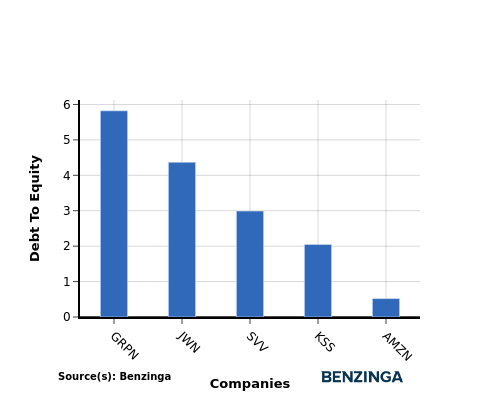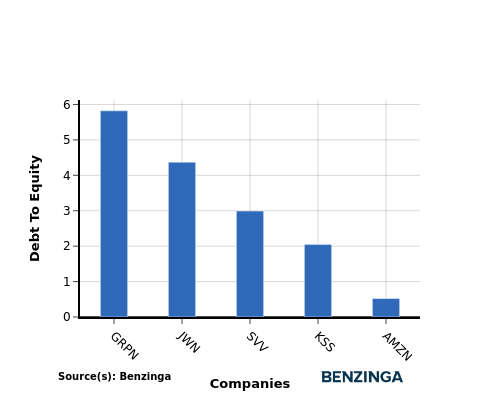Amidst the fast-paced and highly competitive business environment of today, conducting comprehensive company analysis is essential for investors and industry enthusiasts. In this article, we will delve into an extensive industry comparison, evaluating Amazon.com AMZN in comparison to its major competitors within the Broadline Retail industry. By analyzing critical financial metrics, market position, and growth potential, our objective is to provide valuable insights for investors and offer a deeper understanding of company's performance in the industry.
Amazon.com Background
Amazon is the leading online retailer and marketplace for third party sellers. Retail related revenue represents approximately 75% of total, followed by Amazon Web Services' cloud computing, storage, database, and other offerings (15%), advertising services (5% to 10%), and other the remainder. International segments constitute 25% to 30% of Amazon's non-AWS sales, led by Germany, the United Kingdom, and Japan.
| Company | P/E | P/B | P/S | ROE | EBITDA (in billions) | Gross Profit (in billions) | Revenue Growth |
|---|---|---|---|---|---|---|---|
| Amazon.com Inc | 48.51 | 9.21 | 3.91 | 6.19% | $32.08 | $31.0 | 11.04% |
| Alibaba Group Holding Ltd | 17.73 | 1.56 | 1.61 | 4.64% | $54.02 | $92.47 | 5.21% |
| PDD Holdings Inc | 9.87 | 3.62 | 2.87 | 9.38% | $29.18 | $59.65 | 44.33% |
| MercadoLibre Inc | 69.07 | 24.67 | 5.40 | 10.37% | $0.72 | $2.44 | 35.27% |
| JD.com Inc | 11.99 | 1.71 | 0.38 | 5.22% | $15.92 | $45.04 | 5.12% |
| Coupang Inc | 42.01 | 10.26 | 1.49 | 1.74% | $0.28 | $2.27 | 27.2% |
| eBay Inc | 16.03 | 5.62 | 3.16 | 11.59% | $0.95 | $1.85 | 3.04% |
| MINISO Group Holding Ltd | 24.39 | 5.76 | 3.98 | 6.68% | $0.88 | $2.03 | 19.29% |
| Vipshop Holdings Ltd | 6.25 | 1.30 | 0.47 | 2.76% | $1.47 | $4.96 | -9.18% |
| Dillard's Inc | 11.45 | 3.60 | 1.07 | 6.37% | $0.15 | $0.58 | -4.19% |
| Ollie's Bargain Outlet Holdings Inc | 30.96 | 3.92 | 2.83 | 3.14% | $0.08 | $0.22 | 12.41% |
| Macy's Inc | 25.28 | 1.06 | 0.20 | 3.53% | $0.44 | $2.16 | -3.48% |
| Nordstrom Inc | 14.68 | 3.87 | 0.26 | 4.75% | $0.4 | $1.49 | -11.04% |
| Kohl's Corp | 6.90 | 0.45 | 0.10 | 0.58% | $0.35 | $1.6 | -0.59% |
| Savers Value Village Inc | 20.85 | 3.54 | 1.05 | 5.09% | $0.07 | $0.22 | 0.53% |
| Groupon Inc | 18.77 | 12.88 | 0.96 | 34.72% | $0.03 | $0.1 | -9.48% |
| Average | 21.75 | 5.59 | 1.72 | 7.37% | $7.0 | $14.47 | 7.63% |
By closely examining Amazon.com, we can identify the following trends:
-
At 48.51, the stock's Price to Earnings ratio significantly exceeds the industry average by 2.23x, suggesting a premium valuation relative to industry peers.
-
With a Price to Book ratio of 9.21, which is 1.65x the industry average, Amazon.com might be considered overvalued in terms of its book value, as it is trading at a higher multiple compared to its industry peers.
-
The stock's relatively high Price to Sales ratio of 3.91, surpassing the industry average by 2.27x, may indicate an aspect of overvaluation in terms of sales performance.
-
The Return on Equity (ROE) of 6.19% is 1.18% below the industry average, suggesting potential inefficiency in utilizing equity to generate profits.
-
The Earnings Before Interest, Taxes, Depreciation, and Amortization (EBITDA) of $32.08 Billion is 4.58x above the industry average, highlighting stronger profitability and robust cash flow generation.
-
The gross profit of $31.0 Billion is 2.14x above that of its industry, highlighting stronger profitability and higher earnings from its core operations.
-
With a revenue growth of 11.04%, which surpasses the industry average of 7.63%, the company is demonstrating robust sales expansion and gaining market share.
Debt To Equity Ratio

The debt-to-equity (D/E) ratio measures the financial leverage of a company by evaluating its debt relative to its equity.
Considering the debt-to-equity ratio in industry comparisons allows for a concise evaluation of a company's financial health and risk profile, aiding in informed decision-making.
By considering the Debt-to-Equity ratio, Amazon.com can be compared to its top 4 peers, leading to the following observations:
-
When comparing the debt-to-equity ratio, Amazon.com is in a stronger financial position compared to its top 4 peers.
-
The company has a lower level of debt relative to its equity, indicating a more favorable balance between the two with a lower debt-to-equity ratio of 0.52.
Key Takeaways
For Amazon.com, the PE, PB, and PS ratios are all high compared to its peers in the Broadline Retail industry, indicating that the stock may be overvalued. The low ROE suggests that Amazon.com is not generating strong returns on shareholder equity. However, the high EBITDA, gross profit, and revenue growth show that the company is performing well in terms of operational efficiency and revenue generation compared to its industry peers.
This article was generated by Benzinga's automated content engine and reviewed by an editor.
© 2024 Benzinga.com. Benzinga does not provide investment advice. All rights reserved.








